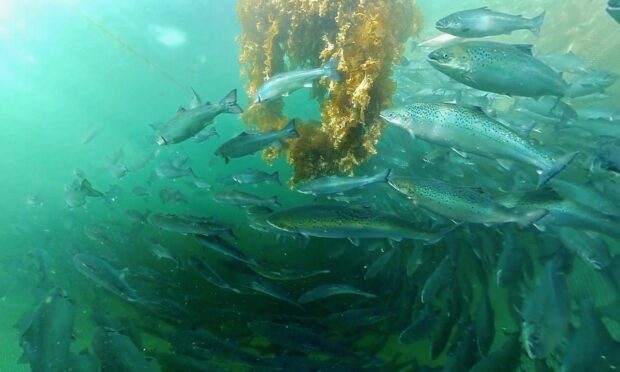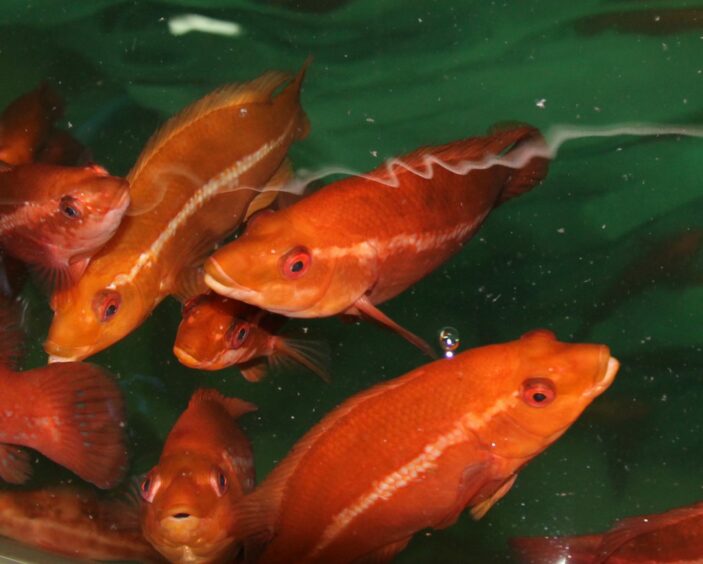Skye firm KelpRing has been awarded innovation funding of £125,000 to support its project to give environment-sensitive salmon farm cleaner fish a home-from-home.
Designed as an alternative to the artificial seaweed hides typically used on fish farms, the KelpRing is intended to replicate as closely as possible the environment ballan wrasse and lumpfish – the most common cleaner fish species – experience in the wild.
It is great to see techniques being trialed to bring the environment of salmon farms closer to what would be found in the wild.”
Sarah Riddle, Sustainable Aquaculture Innovation Centre.
Cleaner fish feed on sea lice, thereby ridding salmon farms of a parasite that costs the aquaculture industry millions of pounds a year in lost output and expensive treatments.
Supported by the Seafood Innovation Fund, with additional input from the Sustainable Aquaculture Innovation Centre (SAIC), salmon producer Loch Duart and Stirling University’s Institute of Aquaculture, new research will see KelpRings installed at one of Loch Duart’s salmon farms for the next 18 months.
SAIC said an earlier feasibility study with Scottish Sea Farms, combined with international research, showed the introduction of natural kelp on salmon farms can have medicinal properties and a calming effect on cleaner fish, boosting their ability to treat sea lice.
Sarah Riddle, director of innovation and engagement, SAIC, said: “Fish health and wellbeing is one of the top priorities for the sector as it continues to target sustainable growth.
“Tools that mimic natural habitats are known to improve the health, welfare, and productivity of cleaner fish.
“For that reason, it is great to see techniques being trialed to bring the environment of salmon farms closer to what would be found in the wild.”
Ballan wrasse and lumpfish are crucial to future-proofing the sector.”
Ms Riddle added: “Aquaculture’s focus on cleaner fish continues to gain momentum, with valuable research developments helping to transform the wider approach to sea lice management.
“Ballan wrasse and lumpfish are crucial to future-proofing the sector, with collaborative research continuing to find new ways of helping them to thrive.”
KelpRing founder Martin Welch said: “Cleaner fish are naturally drawn to seaweed forests and by adding kelp hides to salmon pens, it allows the fish to act as they would in the wild, in their natural habitat.
So far, the aquaculture sector has been incredibly positive about the prospects of using the system.”
Martin Welch, KelpRing.
“Wrasse and lumpfish can live a long and healthy life of up to 25 years if the conditions are right, and measures to enhance their wellbeing can only support their ability to treat sea lice.
“So far, the aquaculture sector has been incredibly positive about the prospects of using the system.
“We’re hopeful the results from this latest trial will prove our hypothesis, with the kelp having a positive impact on Loch Duart’s cleaner fish population and a reduction in sea lice numbers.”
‘Vital and valuable role’
Leading the cleaner fish programe at Scourie-based Loch Duart is Lewis Bennett, who said: “They play a vital and valuable role in the business.
“Being able to express their natural grazing behavior requires a range of factors to be met, such as having a habitat or structure in close proximity.
“We currently use artificial kelp for this, but being able to provide our wrasse with a more appropriate habitat should create a happier fish population and would reduce the need for artificial products.”
Scottish aquaculture project aims to keep parasite-eating fish – and salmon farmers – happy
Skye salmon farmer turns its focus on expansion after royal visit

